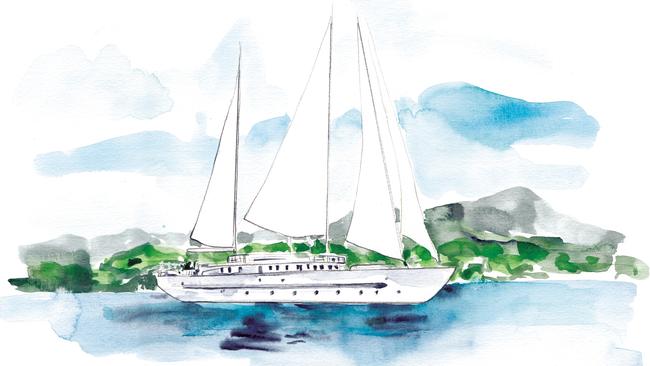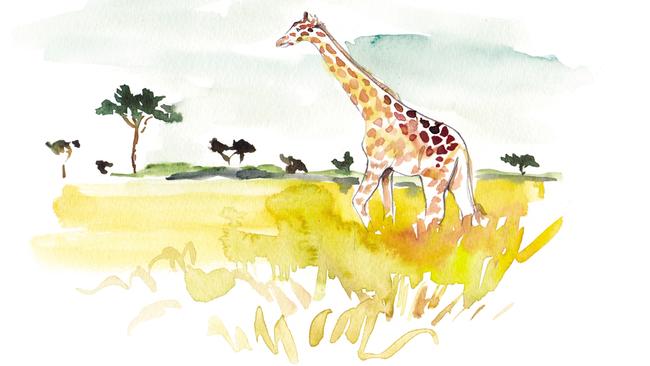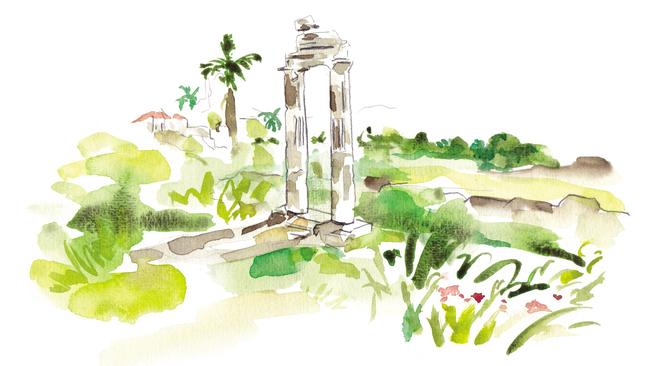Slow, steady travel the new normal
The global welcome mat is out and Australians are on the move again – but with a new, considered approach to travel.

How to travel well as we emerge from the so-called pandemic pause? Let us count the ways. Trends are fast emerging and the news is good. What’s instantly clear from research and statistics provided by destination marketers, tour operators and airlines is that Australians are on the move and, conversely, pretty well staying put when they get there. Just one of the freshly minted neologisms is “slojourns”. The message is all about immersion in a place, making meaningful connections, and shucking off the helter-skelter pace of leaping from one city or even country to another.
The notion of ticking off places on a long checklist has lost its cachet. Slow, steady travel sums it up. Tourism Australia, for example, has identified such holiday patterns as a preference for wide-open and remote destinations but sustainability is a key factor, as are safety and digital connectivity.
Travel is also being recognised as a force for good, says Tourism Australia. Its 2021 consumer research showed 74 per cent of holiday-makers increasingly seek brands that support local businesses or have a hands-on element, even as simple as planting a tree to re-establish wildlife habitats in bushfire-affected areas or knowing that a percentage of profits is ploughed back into communities. Additional research revealed that 91 per cent of respondents equate the benefits of travelling as the opportunity to become more open-minded and knowledgeable about the world.

The past two years have made many of us take stock and perhaps value a little more the sheer wonder of travel, the ability to access the universe’s most rewarding realms, and to do so in hitherto unparalleled comfort, ease and luxury. The idea of the world being our oyster should be a given; we just need to choose how to taste it. Allied to this is the regenerative nature of travel. We find out who we are when we leave our comfort zones. And better versions of ourselves are allied with wellness travel, achieved on spa-focused breaks, yoga camps, meditation retreats at, say, tiny Japanese inns and temples or, more broadly, the calming and uplifting benefits of multi-day hikes or off-grid stays in isolated areas.
A favourite focus is eco-conscious adventure with a soft centre. From members of Luxury Lodges of Australia to New Zealand’s premier inns in pristine regional locations, the range is wide and creature comforts are a given. And the bar is forever being lifted. For example, Australia-based operator Baillie Lodges has acquired Clayoquot Wilderness Lodge, a “wild outpost” on Vancouver Island’s Clayoquot Sound in British Columbia, Canada, and a design makeover of the campaign-style tents has taken place, along with additional nature-based experiences focused on aquatic wildlife, and the likes of canyoning and trail hiking. Outdoorsy types who head to reasonably remote climes are no longer wrestling with DIY tents but instead pitching up to glamping sites, many of which are now attached to wineries, such as Nashdale Lane near Orange in the NSW central tablelands. There’s a democratisation in all this, making outdoors-themed travel more accessible to all.
But let’s not forget “revenge” or “splurge” tourism by those determined to spend holiday funds set aside since early 2020. This sector is already on the move, and the accommodation industry, especially in Europe, is lapping it up. Italian palazzos, Mediterranean villas, Aegean yacht charters and French chateaux have been booked out through the northern summer.
Around the world in 80 days? Europe in a week? No thanks. The pattern now is to choose one country, or sometimes just a region or city, and do it inside out. Meet the locals, eschew sightseeing buses and choose walking tours that connect to neighbourhoods, eat speciality dishes and book a hotel that’s connected to a community. Use that accommodation as a base and a temporary home from which to radiate. This strategy equally applies to regions in Australia with a diversity of attractions and often landscapes. The industry jargon is “authenticity”, playing into the minds of those who eschew the mainstream, seeking pastimes that feel more meaningful and less commercial.

This approach resonates with food-themed travel, often on tours led by celebrity chefs or restaurateurs. The same applies to garden jaunts in the hands of botanic experts. At an even more specialised level, and catering to slightly loftier passions, the likes of Academy Travel and Renaissance Tours offer itineraries linked to art, music and culture. The former limits its groups to 16 members under the guidance of expert specialist leaders, and itinerary themes are as disparate as textiles of India, the Frank Lloyd Wright architecture trail in the US, and the heritage wonders of Puglia and Pompeii. And just a couple of samples of what’s on the diverse agenda for Renaissance Travel: a tour of the artistic highlights of the low countries (Brussels, Ghent, Antwerp, Amsterdam) from Van Eyck to Van Gogh, and an Art Deco to art “now” exploration of Singapore.
Stay well? Guests are increasingly doing their hotel homework and eschewing accommodation that does not incorporate energy-saving practices and waste management policies. Are profits ploughed back into communities and conservation? Paper collateral is going the way of the dinosaur, along with unnecessary items such as towelling slippers and over-wrapped shower caps. Robots could well be the new butlers. Brands are looking for ways to differentiate their offerings, which could get gimmicky, but even the stately old-fashioned properties will need to transform in order to meet demand. This could be as simple as emphasising organic produce in the kitchens, saying goodbye to buffets, keeping beehives on the roof, revamping service delivery to be less formal or intimidating, and upgrading in-room technology to meet new-generation guests’ expectations.
Crucially, the trend is one of scale. Big properties may need to consider adapting to smaller, casual dining venues with more intimate service, crafted menus that showcase regional flavours and the pleasurable possibility of guest-staff interactions. Lobby cafes with breakfast to go will soon be a given in city digs. Developers, from the outset, need to plan for niche accommodation with a design that’s pertinent to a destination rather than an identikit iteration. The upside is that guests are likely to stay longer in a hotel or resort that’s petite, offers privacy, and where staff can intuitively deliver what they need instead of an emphasis on show-off bells and whistles.
-
2022 hit list
Cruise aboard the very French and highly exclusive Le Ponant, a 16-stateroom yacht, on itineraries of seven or 14 days in the Kimberley from 2023.
Discover French Polynesia aboard Paul Gauguin, a recently refurbished cruise ship carrying 332 passengers on circle journeys from Papeete that include stops
at private islets.
Check the Aman portfolio of resorts, remote lodges and city sanctuaries, all of which embody Zen-like calm. Aman New York is the latest to launch, but for absolute sequestration and a true sense of healing, consider Amankora in Bhutan or Amangiri in the Utah desert.
I had a tent in Africa? Make that canvas shelter one of the 10 lined up at Kichakani Serengeti Camp, an improbably well-appointed and stylish mobile encampment in Tanzania that is packed up and relocated with the seasons and patterns of wildlife migration. It’s as close to the Out of Africa dream as a traveller could hope to get.
Combine nature with nurture at Silky Oaks Lodge in the Queensland Daintree, recently reopened by new owner Baillie Lodges with an array of upgrades, including the Daintree Pavilion,
a one-of-a kind multi-level abode with two bedrooms, pool and immersive rainforest locale.
Pitch up at NSW’s best local glamping retreats, from High Sierra near Mudgee and Marramarra Lodge on the banks of the Hawkesbury to the pioneering Paperbark Camp near Jervis Bay. Head to Sal Salis Ningaloo Reef in Western Australia for coastal safari chic and get in the mood for tented sojourns farther afield, including the extraordinary jungle redoubt of Shinta Mani Wild in Cambodia, designed by the exuberant Bill Bensley, where conservation is the keynote and a working partnership with Wildlife Alliance ensures protection of endangered species at risk of poaching and habitat encroachment. It’s not too earnest, though – guests arrive by zipline. Let the bright new
age of travel begin.
-
Get out of here
Jet travel aboard sole-use charters presents a cocoon-like experience without a care in the world. Captain’s Choice is Australia’s leading operator for private jet travel and has expanded its local portfolio over the past two years. Passenger numbers range up to about 40, depending on aircraft, and the all-inclusive cost really does cover the lot. Luxury lodges of NZ is the operator’s signature experience in 2022, along with an expanded array of local options. In 2023, sea and land options are on offer, including a 17-day journey of the remote reaches of Scandinavia, plus walking the Camino (in style) in Spain and visiting remote isles of Britain on a luxury voyage.
Private islands present strong appeal for being away from it all but having it all. Sometimes the island is completely yours, or the framework could be a la COMO Laucala Island in Fiji, with just 25 spaced-apart villas that stand as oases within the broader property. Tiny but perfectly composed is Fiji’s Vatuvara, with just three villas.
The Caribbean has a swag of sole-use options, often with staff zipping across each
day from a satellite isle or port.
Cruising? Think small, go deep. Expedition voyages are the big-ticket items, particularly to the Galapagos, the Kimberley region, Antarctica and the Arctic Circle. Passenger numbers are smaller, ships must comply with the latest environmental safety credentials, excursions are more nature attuned, and there’s a clear sense of being part of a modern-day explorers’ club. This is not the cocktails and cabarets style of cruising but an opportunity to experience the world’s most extreme and virtually inaccessible climes in safety and style.
Getaways with private pool villas are the ultimate choice in a brave new world; capsule-like mini-resorts within a resort will continue to be the prime choice for couples and honeymooners. Destinations with ample inventory and the best design credentials include Bali, southern Thailand and, most comprehensively, The Maldives, where that pool is likely to be perched on a villa deck over a true-blue lagoon. Dive in via slippery dip? Make a splash at sister resorts Soneva Fushi or Soneva Jani, also acknowledged as leaders in marine conservation and research.
Safari experiences elevated with a clear conservation focus will lead the charge in key African destinations. Industry leader Abercrombie & Kent’s small-group expeditions to view the great annual migration of wildlife between Kenya and Tanzania are back on the agenda. Most safari lodges, including the four operated by Sabi Sabi in a private reserve easily accessed by air from Johannesburg, have been retraining staff across multiple skilled roles, including as game rangers, and enhancing wildlife protection measures during the Covid hiatus.
Susan Kurosawa is Associate Editor (Travel) of the Australian




To join the conversation, please log in. Don't have an account? Register
Join the conversation, you are commenting as Logout